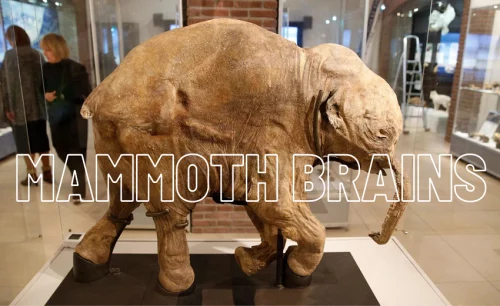Mammoths, the woolly giants that roamed the Earth during the Pleistocene era, were some of the largest land mammals to ever exist. Along with their massive bodies, they also possessed impressive brains. In this article, we will explore the history of mammoth brains and their evolution over time.
The Evolution of Mammoths:
Mammoths first appeared in the fossil record around five million years ago, and they evolved into many different species over time. One of the earliest known species of the mammoth was the Etruscan mammoth, which lived in Europe and Asia during the early Pleistocene era. This species had a brain size similar to that of modern-day elephants, with an average volume of around 4,500 cubic centimetres (cc).
As mammoths continued to evolve, their brain size increased. The woolly mammoth, which lived in the northern regions of North America, Europe, and Asia during the late Pleistocene era, had a brain volume of around 5,700 cc, which is larger than that of modern-day elephants.
The Anatomy of Mammoth Brains:
Mammoth brains had a similar structure to that of modern-day elephants. They had a large cerebrum, which is responsible for complex thought and behaviour, as well as a large cerebellum, which controls movement and coordination.
However, mammoths had some unique features in their brains that set them apart from elephants. For example, the olfactory bulbs, which are responsible for the sense of smell, were much larger in mammoths than in elephants. This suggests that mammoths may have had a stronger sense of smell than elephants, which could have helped them navigate their environment.
The Function of Mammoth Brains:
Mammoths were social animals, and their large brains likely played a role in their social interactions. For example, some scientists believe that mammoths may have had a complex system of communication, using sounds and body language to communicate with each other. Their large cerebrum may have also allowed them to recognize individuals within their social group and remember past interactions.
Mammoths were also highly adaptable animals, able to live in a wide range of environments from the Arctic tundra to grasslands. Their large brains likely played a role in their ability to adapt to changing environments, allowing them to learn new skills and behaviours quickly.
The Extinction of Mammoths:
Despite their impressive brains, mammoths were unable to survive the rapidly changing environment of the late Pleistocene era. The exact cause of their extinction is still a topic of debate among scientists, but it is likely that a combination of factors, including climate change and human hunting, played a role.
As the climate warmed and the ice sheets retreated, the grasslands and tundra that mammoths relied on for food began to disappear. This may have put pressure on their populations, making them more vulnerable to disease and predation.
Human hunting also likely played a role in the extinction of mammoths. Evidence suggests that humans hunted mammoths for their meat and hides, which may have put additional pressure on already stressed populations.
The Legacy of Mammoth Brains:
Today, mammoths are extinct, but their legacy lives on. Scientists continue to study mammoths, using fossils and genetic evidence to learn more about these impressive animals and their evolution over time.
One area of research that is particularly interesting to scientists is the possibility of bringing mammoths back to life through cloning. While this technology is still in its infancy, some scientists believe that it may one day be possible to resurrect mammoths and reintroduce them to the wild.
Conclusion:
The history of mammoth brains is a fascinating subject that sheds light on the evolution and behaviour of these magnificent creatures. As mammoths evolved, their brains grew larger, allowing them to adapt to changing environments and engage in complex social behaviours. Despite their impressive brains, however, mammoths were unable to survive the changing world of the late Pleistocene era, and they eventually went extinct. Nevertheless, their legacy lives on through scientific research and the possibility of cloning, which offers the tantalizing prospect of resurrecting these giants of the past. The study of mammoth brains serves as a reminder of the importance of understanding the evolution and behaviour of extinct species, and how their legacy can still influence our world today.







